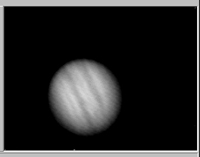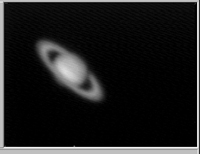

First Light Under Frigid Temperatures - 1/14/00
I was anxious to try the converted greyscale quickcam during the coldest night to date of the winter season. Single digits (F) were expected: the temperature was 7 degrees fahranheit when I tore down at 2:00 am. Would these frigid ambient temperatures allow the greyscale quickcam to show its potential for long exposure imaging? I thought this would be a good test before I equip the unit with a peltier and fan for cooling. I left the quickcam outside a few hours before use. I did not have a temperature sensor on the CCD chip so I have no way of knowing the lowest temperature it reached. The original plastic shell of the quickcam has only very small and too few holes for air circulation. I suspect that heat was generated by the circuitry but I don't know great of an effect this had. An air-cooled housing would surely have been best for cooling to the frigid ambient temperatures.
Since this was a test unit, I decided to hot glue the T-ring thread on the plastic shell so that it could easily be removed. This was a mistake. Just after attaching the quickcam to the flip mirror I heard a crash, and there on the floor were the pieces of my now unassembled quickcam. I reassembled and used superglue to fix it correctly; no damage done. It passed the drop test;)
I first imaged Jupiter and Saturn. Here are the raw screen shots:


These had to be made at the shortest exposure setting in QCV2 to not be overexposed.
Scope used: 10 inch LX200 with 2X barlow on wedge and cement pier. I could tell right away that the Quickcam VC is preferable for planet imaging.
Go to next page: Herring bone interference problem?